Assessment 1: Factors for High Quality of Life and Caring Techniques
VerifiedAdded on 2023/01/13
|11
|3591
|96
Report
AI Summary
This report, prepared for a Public Health Advisor, examines the multifaceted factors influencing an individual's quality of life. It categorizes these factors into internal elements, such as physical and material well-being, and individual factors like education and technology, as well as external environmental influences. The report also outlines key caring techniques essential for effective patient care, including trained staff, clear communication, and the use of new technologies. Furthermore, it addresses the constraints that can hinder positive caring, offering a comprehensive overview of the subject. The report emphasizes the importance of a holistic approach to healthcare, focusing on both the physical and emotional well-being of patients to improve their overall quality of life. It underscores the need for continuous improvement in healthcare practices and policies to meet the evolving needs of individuals and society.
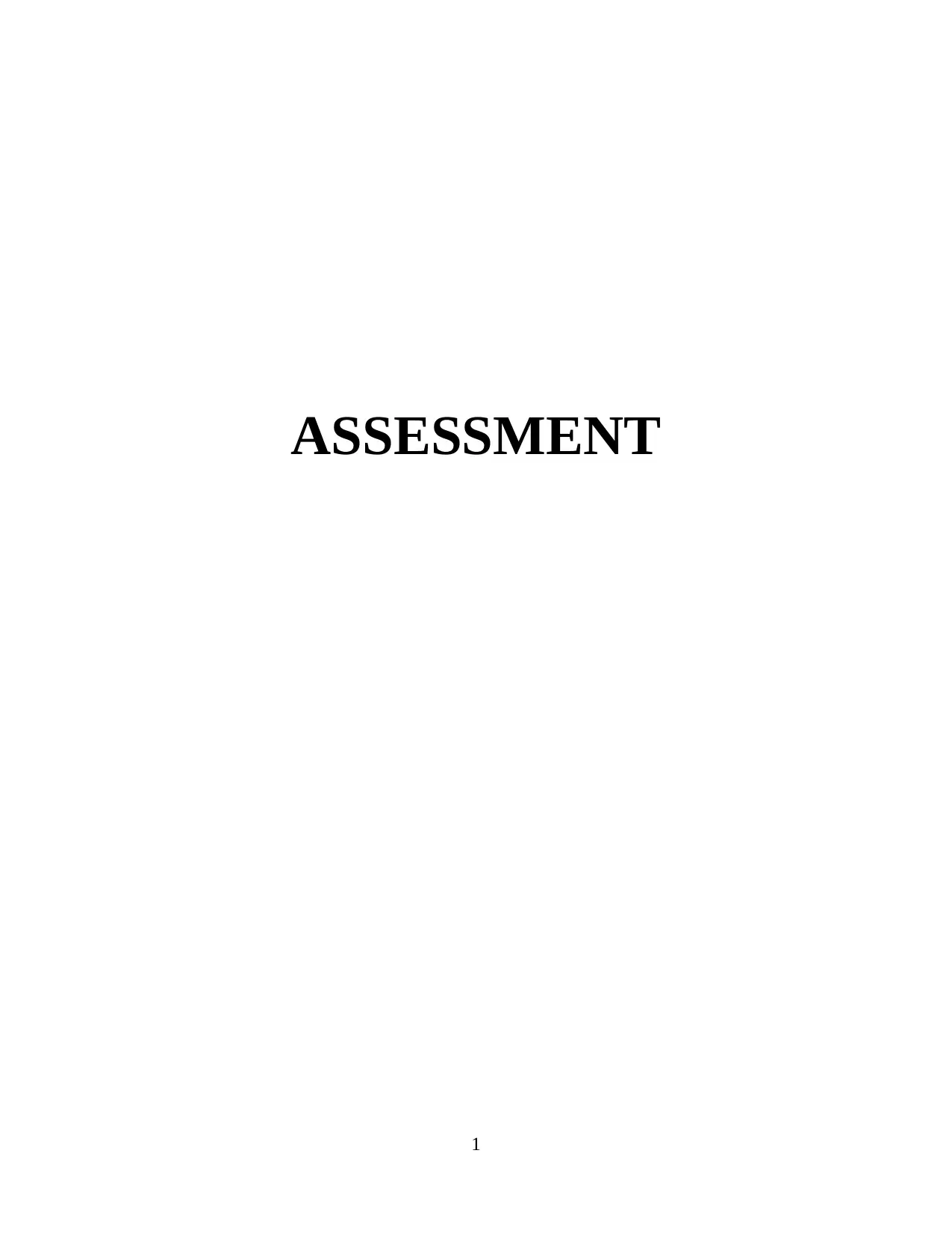
ASSESSMENT
1
1
Paraphrase This Document
Need a fresh take? Get an instant paraphrase of this document with our AI Paraphraser
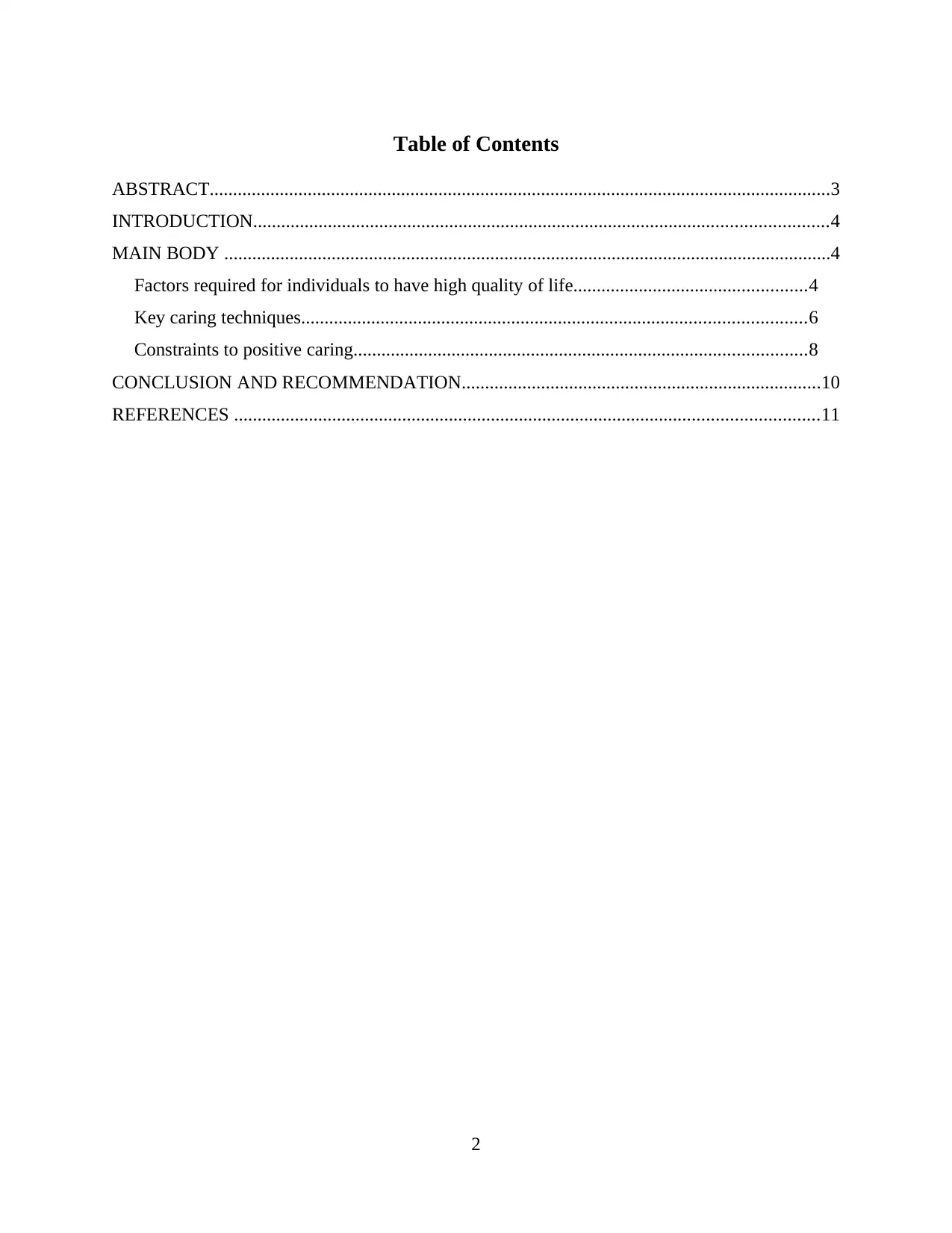
Table of Contents
ABSTRACT.....................................................................................................................................3
INTRODUCTION...........................................................................................................................4
MAIN BODY ..................................................................................................................................4
Factors required for individuals to have high quality of life..................................................4
Key caring techniques............................................................................................................6
Constraints to positive caring.................................................................................................8
CONCLUSION AND RECOMMENDATION.............................................................................10
REFERENCES .............................................................................................................................11
2
ABSTRACT.....................................................................................................................................3
INTRODUCTION...........................................................................................................................4
MAIN BODY ..................................................................................................................................4
Factors required for individuals to have high quality of life..................................................4
Key caring techniques............................................................................................................6
Constraints to positive caring.................................................................................................8
CONCLUSION AND RECOMMENDATION.............................................................................10
REFERENCES .............................................................................................................................11
2
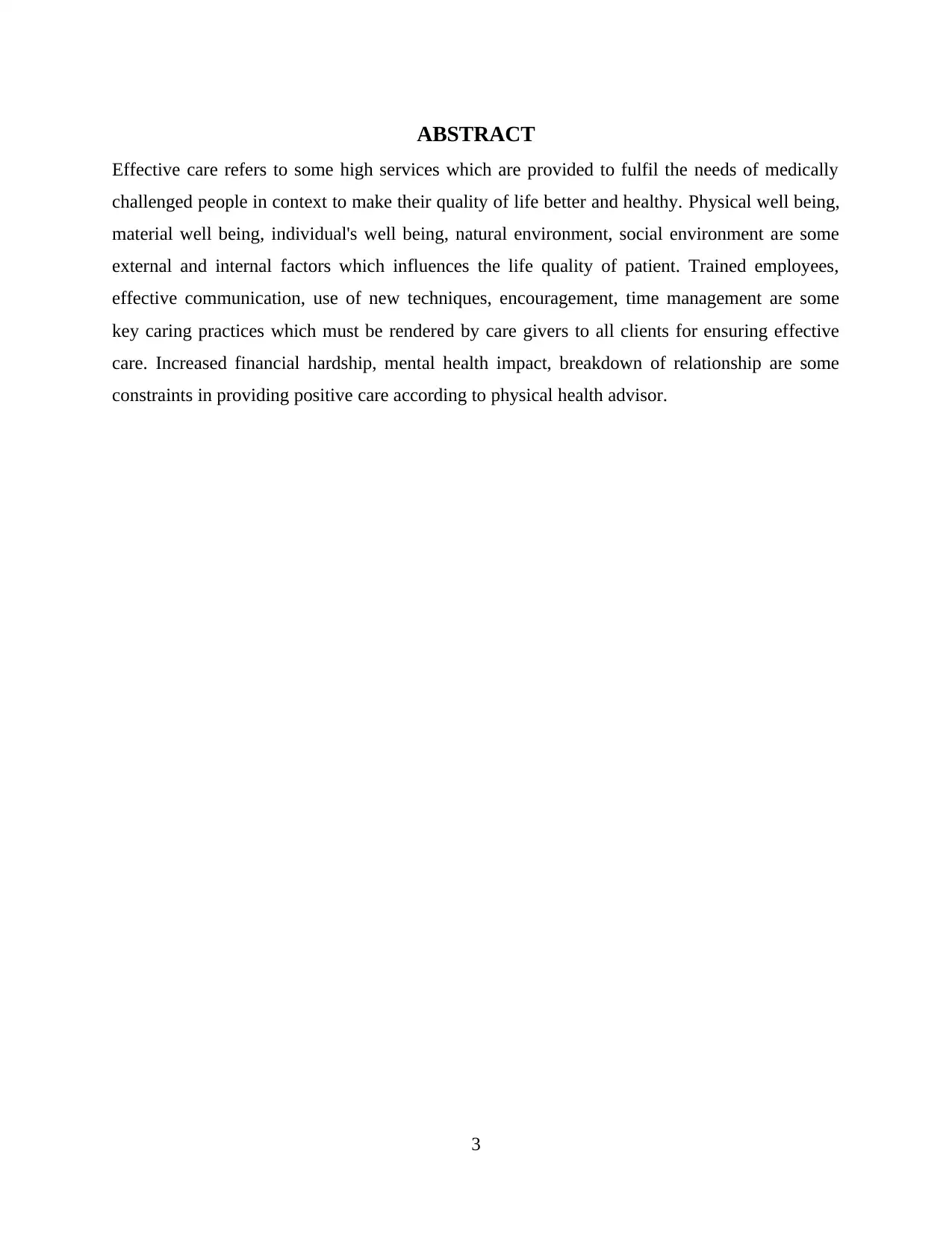
ABSTRACT
Effective care refers to some high services which are provided to fulfil the needs of medically
challenged people in context to make their quality of life better and healthy. Physical well being,
material well being, individual's well being, natural environment, social environment are some
external and internal factors which influences the life quality of patient. Trained employees,
effective communication, use of new techniques, encouragement, time management are some
key caring practices which must be rendered by care givers to all clients for ensuring effective
care. Increased financial hardship, mental health impact, breakdown of relationship are some
constraints in providing positive care according to physical health advisor.
3
Effective care refers to some high services which are provided to fulfil the needs of medically
challenged people in context to make their quality of life better and healthy. Physical well being,
material well being, individual's well being, natural environment, social environment are some
external and internal factors which influences the life quality of patient. Trained employees,
effective communication, use of new techniques, encouragement, time management are some
key caring practices which must be rendered by care givers to all clients for ensuring effective
care. Increased financial hardship, mental health impact, breakdown of relationship are some
constraints in providing positive care according to physical health advisor.
3
⊘ This is a preview!⊘
Do you want full access?
Subscribe today to unlock all pages.

Trusted by 1+ million students worldwide
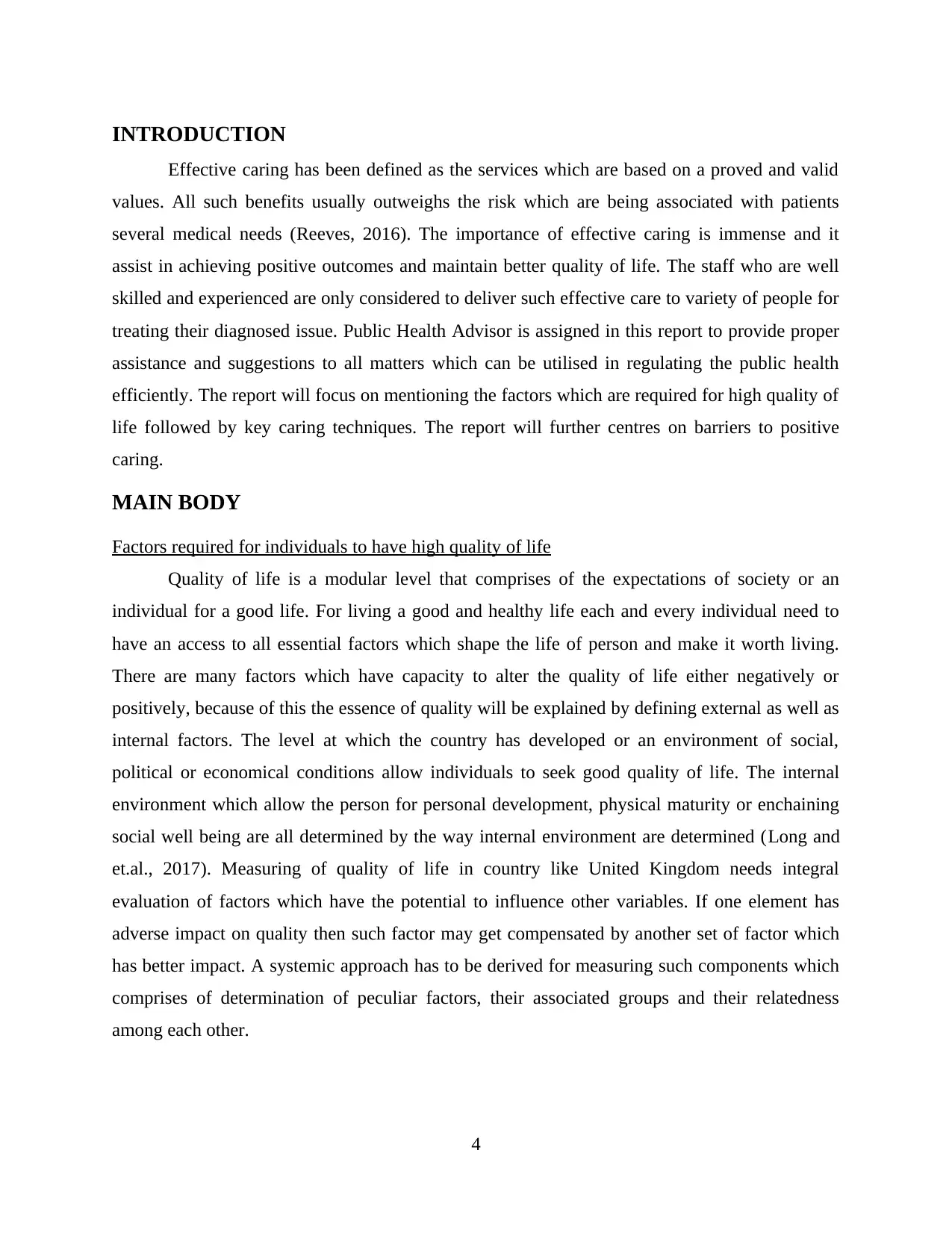
INTRODUCTION
Effective caring has been defined as the services which are based on a proved and valid
values. All such benefits usually outweighs the risk which are being associated with patients
several medical needs (Reeves, 2016). The importance of effective caring is immense and it
assist in achieving positive outcomes and maintain better quality of life. The staff who are well
skilled and experienced are only considered to deliver such effective care to variety of people for
treating their diagnosed issue. Public Health Advisor is assigned in this report to provide proper
assistance and suggestions to all matters which can be utilised in regulating the public health
efficiently. The report will focus on mentioning the factors which are required for high quality of
life followed by key caring techniques. The report will further centres on barriers to positive
caring.
MAIN BODY
Factors required for individuals to have high quality of life
Quality of life is a modular level that comprises of the expectations of society or an
individual for a good life. For living a good and healthy life each and every individual need to
have an access to all essential factors which shape the life of person and make it worth living.
There are many factors which have capacity to alter the quality of life either negatively or
positively, because of this the essence of quality will be explained by defining external as well as
internal factors. The level at which the country has developed or an environment of social,
political or economical conditions allow individuals to seek good quality of life. The internal
environment which allow the person for personal development, physical maturity or enchaining
social well being are all determined by the way internal environment are determined (Long and
et.al., 2017). Measuring of quality of life in country like United Kingdom needs integral
evaluation of factors which have the potential to influence other variables. If one element has
adverse impact on quality then such factor may get compensated by another set of factor which
has better impact. A systemic approach has to be derived for measuring such components which
comprises of determination of peculiar factors, their associated groups and their relatedness
among each other.
4
Effective caring has been defined as the services which are based on a proved and valid
values. All such benefits usually outweighs the risk which are being associated with patients
several medical needs (Reeves, 2016). The importance of effective caring is immense and it
assist in achieving positive outcomes and maintain better quality of life. The staff who are well
skilled and experienced are only considered to deliver such effective care to variety of people for
treating their diagnosed issue. Public Health Advisor is assigned in this report to provide proper
assistance and suggestions to all matters which can be utilised in regulating the public health
efficiently. The report will focus on mentioning the factors which are required for high quality of
life followed by key caring techniques. The report will further centres on barriers to positive
caring.
MAIN BODY
Factors required for individuals to have high quality of life
Quality of life is a modular level that comprises of the expectations of society or an
individual for a good life. For living a good and healthy life each and every individual need to
have an access to all essential factors which shape the life of person and make it worth living.
There are many factors which have capacity to alter the quality of life either negatively or
positively, because of this the essence of quality will be explained by defining external as well as
internal factors. The level at which the country has developed or an environment of social,
political or economical conditions allow individuals to seek good quality of life. The internal
environment which allow the person for personal development, physical maturity or enchaining
social well being are all determined by the way internal environment are determined (Long and
et.al., 2017). Measuring of quality of life in country like United Kingdom needs integral
evaluation of factors which have the potential to influence other variables. If one element has
adverse impact on quality then such factor may get compensated by another set of factor which
has better impact. A systemic approach has to be derived for measuring such components which
comprises of determination of peculiar factors, their associated groups and their relatedness
among each other.
4
Paraphrase This Document
Need a fresh take? Get an instant paraphrase of this document with our AI Paraphraser
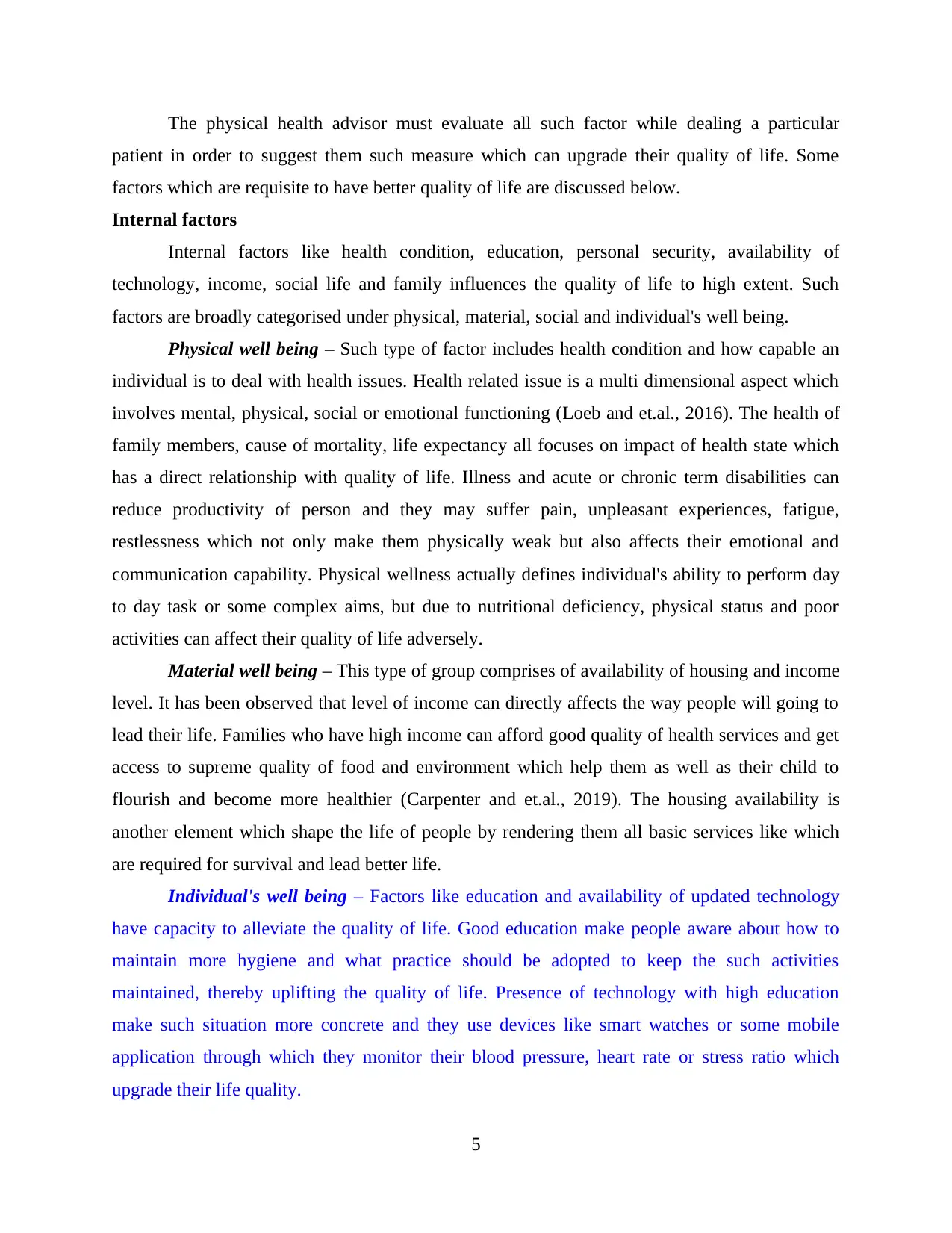
The physical health advisor must evaluate all such factor while dealing a particular
patient in order to suggest them such measure which can upgrade their quality of life. Some
factors which are requisite to have better quality of life are discussed below.
Internal factors
Internal factors like health condition, education, personal security, availability of
technology, income, social life and family influences the quality of life to high extent. Such
factors are broadly categorised under physical, material, social and individual's well being.
Physical well being – Such type of factor includes health condition and how capable an
individual is to deal with health issues. Health related issue is a multi dimensional aspect which
involves mental, physical, social or emotional functioning (Loeb and et.al., 2016). The health of
family members, cause of mortality, life expectancy all focuses on impact of health state which
has a direct relationship with quality of life. Illness and acute or chronic term disabilities can
reduce productivity of person and they may suffer pain, unpleasant experiences, fatigue,
restlessness which not only make them physically weak but also affects their emotional and
communication capability. Physical wellness actually defines individual's ability to perform day
to day task or some complex aims, but due to nutritional deficiency, physical status and poor
activities can affect their quality of life adversely.
Material well being – This type of group comprises of availability of housing and income
level. It has been observed that level of income can directly affects the way people will going to
lead their life. Families who have high income can afford good quality of health services and get
access to supreme quality of food and environment which help them as well as their child to
flourish and become more healthier (Carpenter and et.al., 2019). The housing availability is
another element which shape the life of people by rendering them all basic services like which
are required for survival and lead better life.
Individual's well being – Factors like education and availability of updated technology
have capacity to alleviate the quality of life. Good education make people aware about how to
maintain more hygiene and what practice should be adopted to keep the such activities
maintained, thereby uplifting the quality of life. Presence of technology with high education
make such situation more concrete and they use devices like smart watches or some mobile
application through which they monitor their blood pressure, heart rate or stress ratio which
upgrade their life quality.
5
patient in order to suggest them such measure which can upgrade their quality of life. Some
factors which are requisite to have better quality of life are discussed below.
Internal factors
Internal factors like health condition, education, personal security, availability of
technology, income, social life and family influences the quality of life to high extent. Such
factors are broadly categorised under physical, material, social and individual's well being.
Physical well being – Such type of factor includes health condition and how capable an
individual is to deal with health issues. Health related issue is a multi dimensional aspect which
involves mental, physical, social or emotional functioning (Loeb and et.al., 2016). The health of
family members, cause of mortality, life expectancy all focuses on impact of health state which
has a direct relationship with quality of life. Illness and acute or chronic term disabilities can
reduce productivity of person and they may suffer pain, unpleasant experiences, fatigue,
restlessness which not only make them physically weak but also affects their emotional and
communication capability. Physical wellness actually defines individual's ability to perform day
to day task or some complex aims, but due to nutritional deficiency, physical status and poor
activities can affect their quality of life adversely.
Material well being – This type of group comprises of availability of housing and income
level. It has been observed that level of income can directly affects the way people will going to
lead their life. Families who have high income can afford good quality of health services and get
access to supreme quality of food and environment which help them as well as their child to
flourish and become more healthier (Carpenter and et.al., 2019). The housing availability is
another element which shape the life of people by rendering them all basic services like which
are required for survival and lead better life.
Individual's well being – Factors like education and availability of updated technology
have capacity to alleviate the quality of life. Good education make people aware about how to
maintain more hygiene and what practice should be adopted to keep the such activities
maintained, thereby uplifting the quality of life. Presence of technology with high education
make such situation more concrete and they use devices like smart watches or some mobile
application through which they monitor their blood pressure, heart rate or stress ratio which
upgrade their life quality.
5
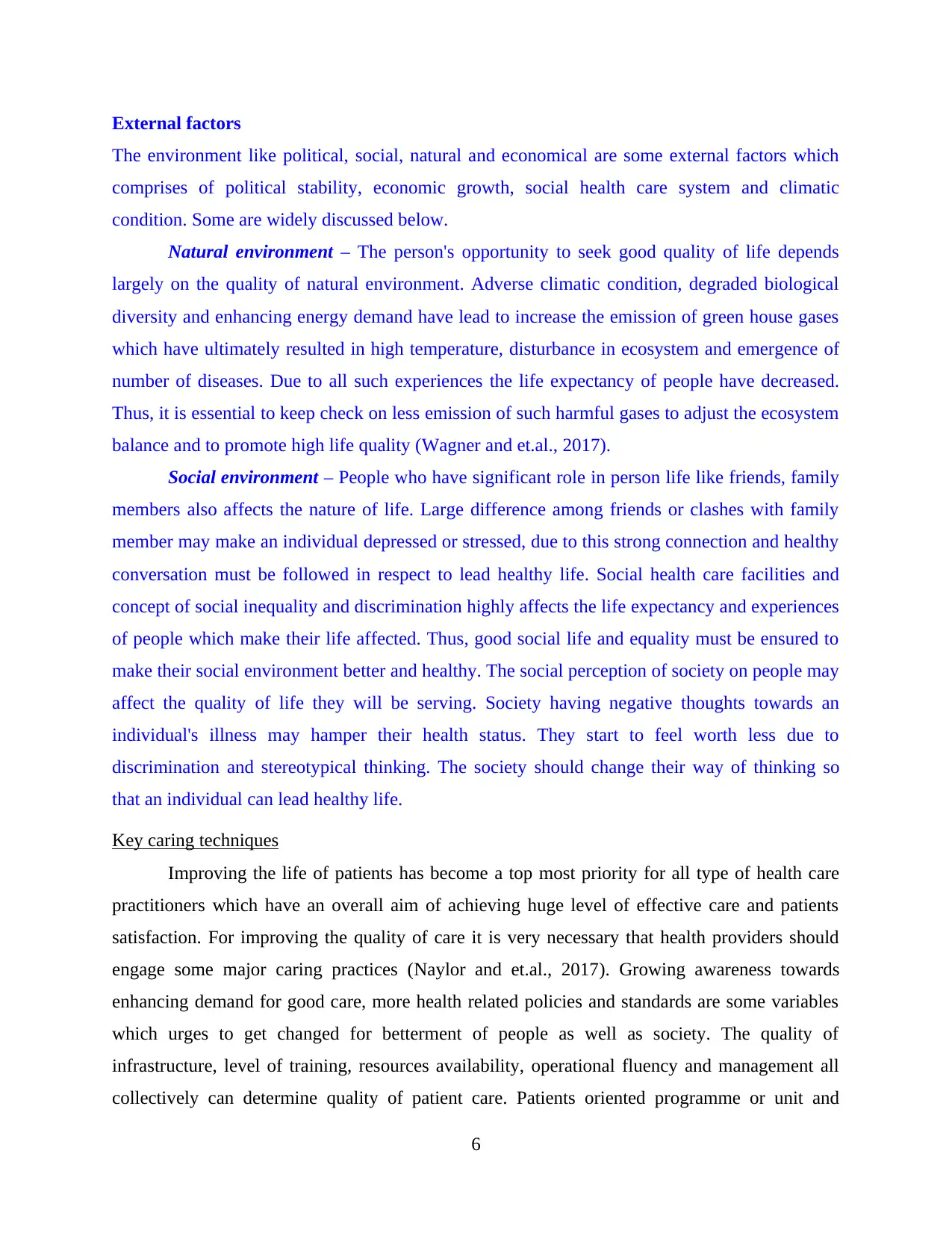
External factors
The environment like political, social, natural and economical are some external factors which
comprises of political stability, economic growth, social health care system and climatic
condition. Some are widely discussed below.
Natural environment – The person's opportunity to seek good quality of life depends
largely on the quality of natural environment. Adverse climatic condition, degraded biological
diversity and enhancing energy demand have lead to increase the emission of green house gases
which have ultimately resulted in high temperature, disturbance in ecosystem and emergence of
number of diseases. Due to all such experiences the life expectancy of people have decreased.
Thus, it is essential to keep check on less emission of such harmful gases to adjust the ecosystem
balance and to promote high life quality (Wagner and et.al., 2017).
Social environment – People who have significant role in person life like friends, family
members also affects the nature of life. Large difference among friends or clashes with family
member may make an individual depressed or stressed, due to this strong connection and healthy
conversation must be followed in respect to lead healthy life. Social health care facilities and
concept of social inequality and discrimination highly affects the life expectancy and experiences
of people which make their life affected. Thus, good social life and equality must be ensured to
make their social environment better and healthy. The social perception of society on people may
affect the quality of life they will be serving. Society having negative thoughts towards an
individual's illness may hamper their health status. They start to feel worth less due to
discrimination and stereotypical thinking. The society should change their way of thinking so
that an individual can lead healthy life.
Key caring techniques
Improving the life of patients has become a top most priority for all type of health care
practitioners which have an overall aim of achieving huge level of effective care and patients
satisfaction. For improving the quality of care it is very necessary that health providers should
engage some major caring practices (Naylor and et.al., 2017). Growing awareness towards
enhancing demand for good care, more health related policies and standards are some variables
which urges to get changed for betterment of people as well as society. The quality of
infrastructure, level of training, resources availability, operational fluency and management all
collectively can determine quality of patient care. Patients oriented programme or unit and
6
The environment like political, social, natural and economical are some external factors which
comprises of political stability, economic growth, social health care system and climatic
condition. Some are widely discussed below.
Natural environment – The person's opportunity to seek good quality of life depends
largely on the quality of natural environment. Adverse climatic condition, degraded biological
diversity and enhancing energy demand have lead to increase the emission of green house gases
which have ultimately resulted in high temperature, disturbance in ecosystem and emergence of
number of diseases. Due to all such experiences the life expectancy of people have decreased.
Thus, it is essential to keep check on less emission of such harmful gases to adjust the ecosystem
balance and to promote high life quality (Wagner and et.al., 2017).
Social environment – People who have significant role in person life like friends, family
members also affects the nature of life. Large difference among friends or clashes with family
member may make an individual depressed or stressed, due to this strong connection and healthy
conversation must be followed in respect to lead healthy life. Social health care facilities and
concept of social inequality and discrimination highly affects the life expectancy and experiences
of people which make their life affected. Thus, good social life and equality must be ensured to
make their social environment better and healthy. The social perception of society on people may
affect the quality of life they will be serving. Society having negative thoughts towards an
individual's illness may hamper their health status. They start to feel worth less due to
discrimination and stereotypical thinking. The society should change their way of thinking so
that an individual can lead healthy life.
Key caring techniques
Improving the life of patients has become a top most priority for all type of health care
practitioners which have an overall aim of achieving huge level of effective care and patients
satisfaction. For improving the quality of care it is very necessary that health providers should
engage some major caring practices (Naylor and et.al., 2017). Growing awareness towards
enhancing demand for good care, more health related policies and standards are some variables
which urges to get changed for betterment of people as well as society. The quality of
infrastructure, level of training, resources availability, operational fluency and management all
collectively can determine quality of patient care. Patients oriented programme or unit and
6
⊘ This is a preview!⊘
Do you want full access?
Subscribe today to unlock all pages.

Trusted by 1+ million students worldwide
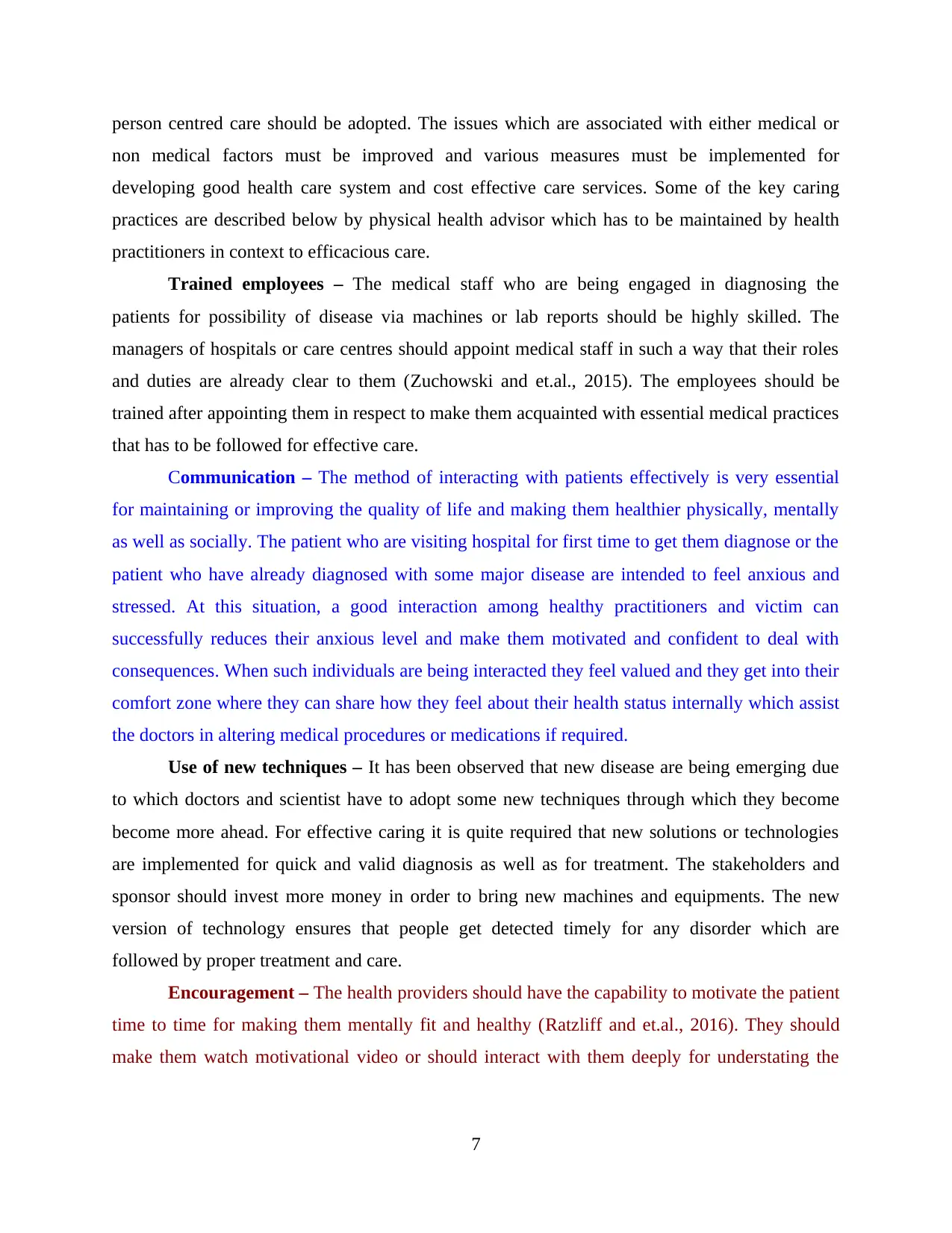
person centred care should be adopted. The issues which are associated with either medical or
non medical factors must be improved and various measures must be implemented for
developing good health care system and cost effective care services. Some of the key caring
practices are described below by physical health advisor which has to be maintained by health
practitioners in context to efficacious care.
Trained employees – The medical staff who are being engaged in diagnosing the
patients for possibility of disease via machines or lab reports should be highly skilled. The
managers of hospitals or care centres should appoint medical staff in such a way that their roles
and duties are already clear to them (Zuchowski and et.al., 2015). The employees should be
trained after appointing them in respect to make them acquainted with essential medical practices
that has to be followed for effective care.
Communication – The method of interacting with patients effectively is very essential
for maintaining or improving the quality of life and making them healthier physically, mentally
as well as socially. The patient who are visiting hospital for first time to get them diagnose or the
patient who have already diagnosed with some major disease are intended to feel anxious and
stressed. At this situation, a good interaction among healthy practitioners and victim can
successfully reduces their anxious level and make them motivated and confident to deal with
consequences. When such individuals are being interacted they feel valued and they get into their
comfort zone where they can share how they feel about their health status internally which assist
the doctors in altering medical procedures or medications if required.
Use of new techniques – It has been observed that new disease are being emerging due
to which doctors and scientist have to adopt some new techniques through which they become
become more ahead. For effective caring it is quite required that new solutions or technologies
are implemented for quick and valid diagnosis as well as for treatment. The stakeholders and
sponsor should invest more money in order to bring new machines and equipments. The new
version of technology ensures that people get detected timely for any disorder which are
followed by proper treatment and care.
Encouragement – The health providers should have the capability to motivate the patient
time to time for making them mentally fit and healthy (Ratzliff and et.al., 2016). They should
make them watch motivational video or should interact with them deeply for understating the
7
non medical factors must be improved and various measures must be implemented for
developing good health care system and cost effective care services. Some of the key caring
practices are described below by physical health advisor which has to be maintained by health
practitioners in context to efficacious care.
Trained employees – The medical staff who are being engaged in diagnosing the
patients for possibility of disease via machines or lab reports should be highly skilled. The
managers of hospitals or care centres should appoint medical staff in such a way that their roles
and duties are already clear to them (Zuchowski and et.al., 2015). The employees should be
trained after appointing them in respect to make them acquainted with essential medical practices
that has to be followed for effective care.
Communication – The method of interacting with patients effectively is very essential
for maintaining or improving the quality of life and making them healthier physically, mentally
as well as socially. The patient who are visiting hospital for first time to get them diagnose or the
patient who have already diagnosed with some major disease are intended to feel anxious and
stressed. At this situation, a good interaction among healthy practitioners and victim can
successfully reduces their anxious level and make them motivated and confident to deal with
consequences. When such individuals are being interacted they feel valued and they get into their
comfort zone where they can share how they feel about their health status internally which assist
the doctors in altering medical procedures or medications if required.
Use of new techniques – It has been observed that new disease are being emerging due
to which doctors and scientist have to adopt some new techniques through which they become
become more ahead. For effective caring it is quite required that new solutions or technologies
are implemented for quick and valid diagnosis as well as for treatment. The stakeholders and
sponsor should invest more money in order to bring new machines and equipments. The new
version of technology ensures that people get detected timely for any disorder which are
followed by proper treatment and care.
Encouragement – The health providers should have the capability to motivate the patient
time to time for making them mentally fit and healthy (Ratzliff and et.al., 2016). They should
make them watch motivational video or should interact with them deeply for understating the
7
Paraphrase This Document
Need a fresh take? Get an instant paraphrase of this document with our AI Paraphraser
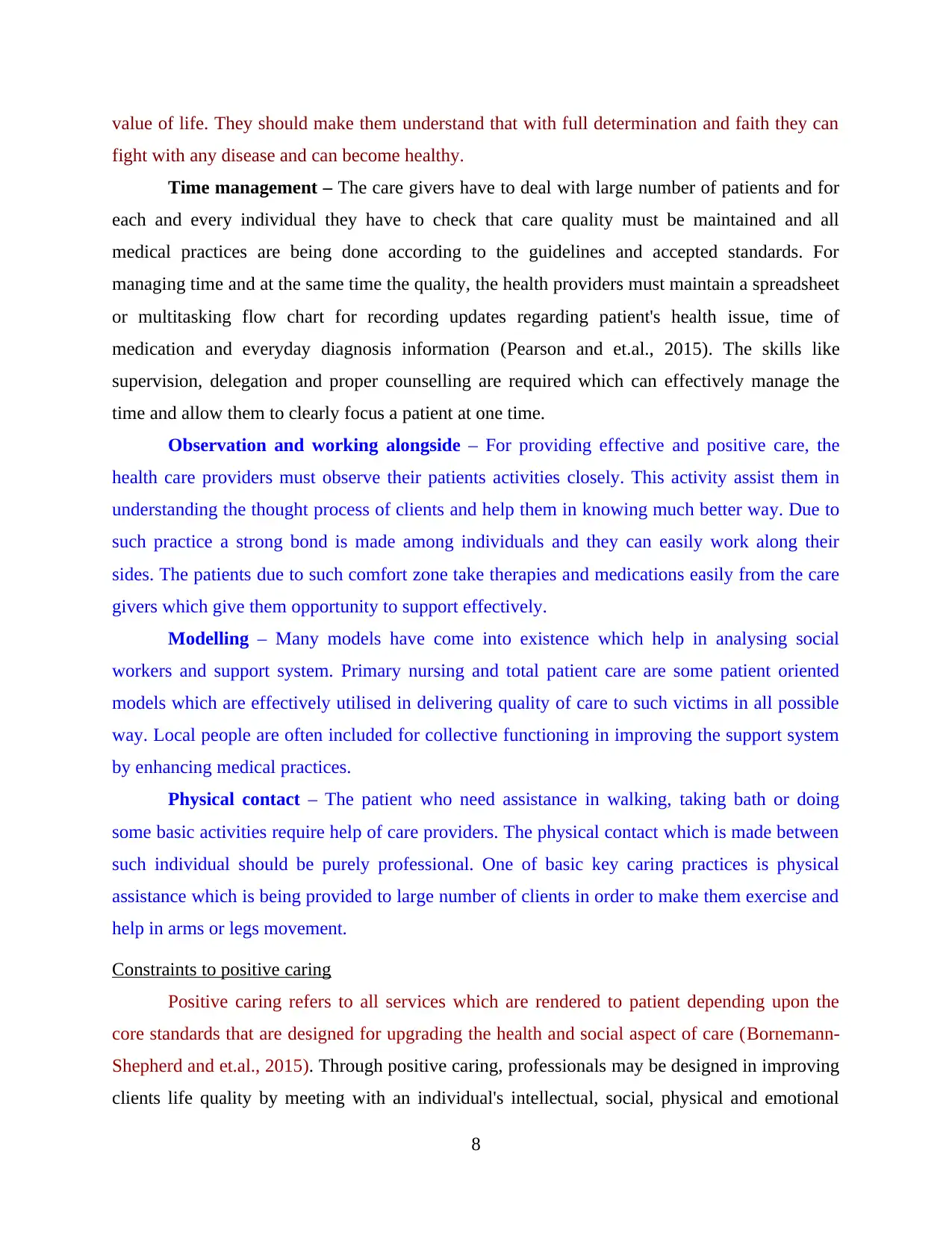
value of life. They should make them understand that with full determination and faith they can
fight with any disease and can become healthy.
Time management – The care givers have to deal with large number of patients and for
each and every individual they have to check that care quality must be maintained and all
medical practices are being done according to the guidelines and accepted standards. For
managing time and at the same time the quality, the health providers must maintain a spreadsheet
or multitasking flow chart for recording updates regarding patient's health issue, time of
medication and everyday diagnosis information (Pearson and et.al., 2015). The skills like
supervision, delegation and proper counselling are required which can effectively manage the
time and allow them to clearly focus a patient at one time.
Observation and working alongside – For providing effective and positive care, the
health care providers must observe their patients activities closely. This activity assist them in
understanding the thought process of clients and help them in knowing much better way. Due to
such practice a strong bond is made among individuals and they can easily work along their
sides. The patients due to such comfort zone take therapies and medications easily from the care
givers which give them opportunity to support effectively.
Modelling – Many models have come into existence which help in analysing social
workers and support system. Primary nursing and total patient care are some patient oriented
models which are effectively utilised in delivering quality of care to such victims in all possible
way. Local people are often included for collective functioning in improving the support system
by enhancing medical practices.
Physical contact – The patient who need assistance in walking, taking bath or doing
some basic activities require help of care providers. The physical contact which is made between
such individual should be purely professional. One of basic key caring practices is physical
assistance which is being provided to large number of clients in order to make them exercise and
help in arms or legs movement.
Constraints to positive caring
Positive caring refers to all services which are rendered to patient depending upon the
core standards that are designed for upgrading the health and social aspect of care (Bornemann-
Shepherd and et.al., 2015). Through positive caring, professionals may be designed in improving
clients life quality by meeting with an individual's intellectual, social, physical and emotional
8
fight with any disease and can become healthy.
Time management – The care givers have to deal with large number of patients and for
each and every individual they have to check that care quality must be maintained and all
medical practices are being done according to the guidelines and accepted standards. For
managing time and at the same time the quality, the health providers must maintain a spreadsheet
or multitasking flow chart for recording updates regarding patient's health issue, time of
medication and everyday diagnosis information (Pearson and et.al., 2015). The skills like
supervision, delegation and proper counselling are required which can effectively manage the
time and allow them to clearly focus a patient at one time.
Observation and working alongside – For providing effective and positive care, the
health care providers must observe their patients activities closely. This activity assist them in
understanding the thought process of clients and help them in knowing much better way. Due to
such practice a strong bond is made among individuals and they can easily work along their
sides. The patients due to such comfort zone take therapies and medications easily from the care
givers which give them opportunity to support effectively.
Modelling – Many models have come into existence which help in analysing social
workers and support system. Primary nursing and total patient care are some patient oriented
models which are effectively utilised in delivering quality of care to such victims in all possible
way. Local people are often included for collective functioning in improving the support system
by enhancing medical practices.
Physical contact – The patient who need assistance in walking, taking bath or doing
some basic activities require help of care providers. The physical contact which is made between
such individual should be purely professional. One of basic key caring practices is physical
assistance which is being provided to large number of clients in order to make them exercise and
help in arms or legs movement.
Constraints to positive caring
Positive caring refers to all services which are rendered to patient depending upon the
core standards that are designed for upgrading the health and social aspect of care (Bornemann-
Shepherd and et.al., 2015). Through positive caring, professionals may be designed in improving
clients life quality by meeting with an individual's intellectual, social, physical and emotional
8
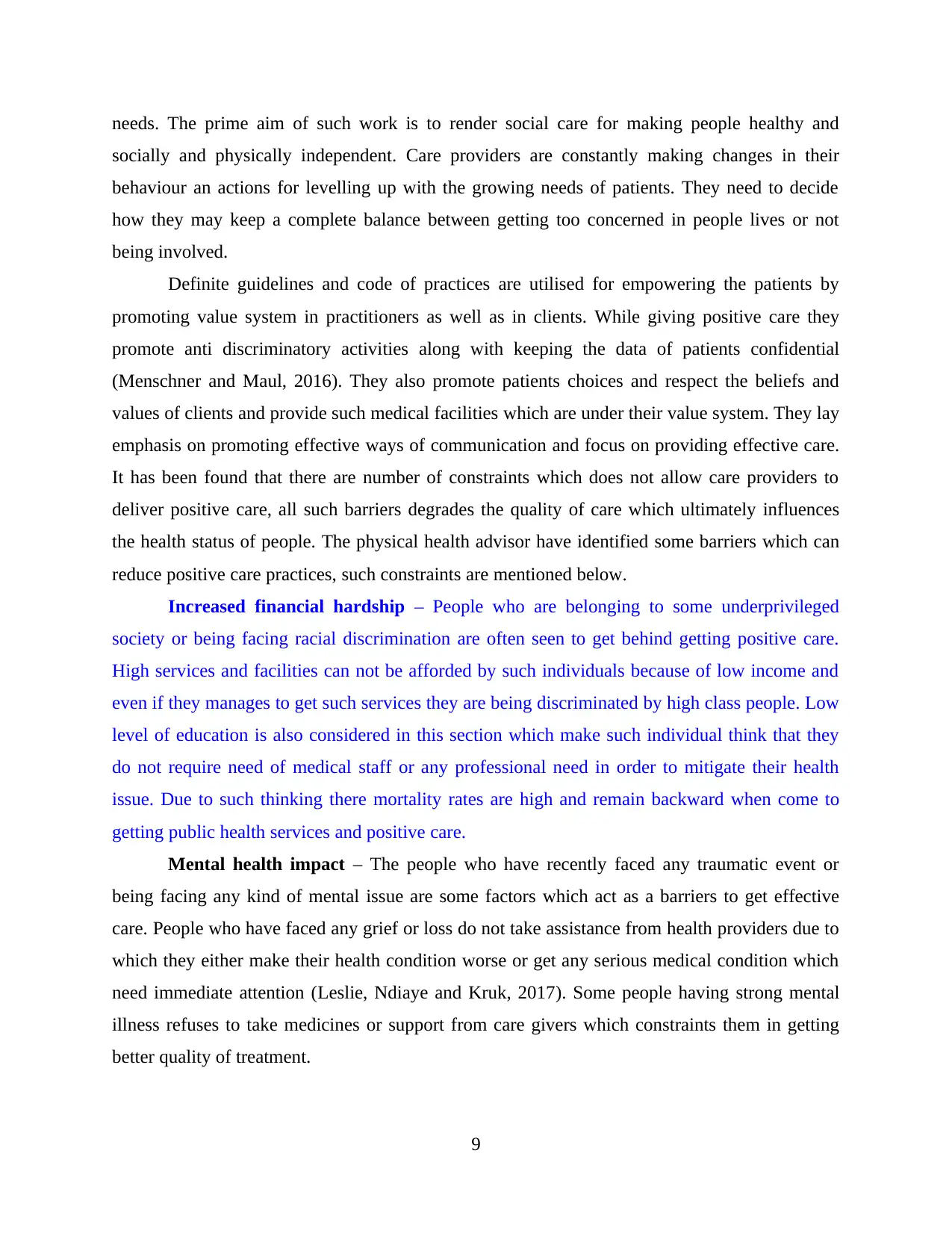
needs. The prime aim of such work is to render social care for making people healthy and
socially and physically independent. Care providers are constantly making changes in their
behaviour an actions for levelling up with the growing needs of patients. They need to decide
how they may keep a complete balance between getting too concerned in people lives or not
being involved.
Definite guidelines and code of practices are utilised for empowering the patients by
promoting value system in practitioners as well as in clients. While giving positive care they
promote anti discriminatory activities along with keeping the data of patients confidential
(Menschner and Maul, 2016). They also promote patients choices and respect the beliefs and
values of clients and provide such medical facilities which are under their value system. They lay
emphasis on promoting effective ways of communication and focus on providing effective care.
It has been found that there are number of constraints which does not allow care providers to
deliver positive care, all such barriers degrades the quality of care which ultimately influences
the health status of people. The physical health advisor have identified some barriers which can
reduce positive care practices, such constraints are mentioned below.
Increased financial hardship – People who are belonging to some underprivileged
society or being facing racial discrimination are often seen to get behind getting positive care.
High services and facilities can not be afforded by such individuals because of low income and
even if they manages to get such services they are being discriminated by high class people. Low
level of education is also considered in this section which make such individual think that they
do not require need of medical staff or any professional need in order to mitigate their health
issue. Due to such thinking there mortality rates are high and remain backward when come to
getting public health services and positive care.
Mental health impact – The people who have recently faced any traumatic event or
being facing any kind of mental issue are some factors which act as a barriers to get effective
care. People who have faced any grief or loss do not take assistance from health providers due to
which they either make their health condition worse or get any serious medical condition which
need immediate attention (Leslie, Ndiaye and Kruk, 2017). Some people having strong mental
illness refuses to take medicines or support from care givers which constraints them in getting
better quality of treatment.
9
socially and physically independent. Care providers are constantly making changes in their
behaviour an actions for levelling up with the growing needs of patients. They need to decide
how they may keep a complete balance between getting too concerned in people lives or not
being involved.
Definite guidelines and code of practices are utilised for empowering the patients by
promoting value system in practitioners as well as in clients. While giving positive care they
promote anti discriminatory activities along with keeping the data of patients confidential
(Menschner and Maul, 2016). They also promote patients choices and respect the beliefs and
values of clients and provide such medical facilities which are under their value system. They lay
emphasis on promoting effective ways of communication and focus on providing effective care.
It has been found that there are number of constraints which does not allow care providers to
deliver positive care, all such barriers degrades the quality of care which ultimately influences
the health status of people. The physical health advisor have identified some barriers which can
reduce positive care practices, such constraints are mentioned below.
Increased financial hardship – People who are belonging to some underprivileged
society or being facing racial discrimination are often seen to get behind getting positive care.
High services and facilities can not be afforded by such individuals because of low income and
even if they manages to get such services they are being discriminated by high class people. Low
level of education is also considered in this section which make such individual think that they
do not require need of medical staff or any professional need in order to mitigate their health
issue. Due to such thinking there mortality rates are high and remain backward when come to
getting public health services and positive care.
Mental health impact – The people who have recently faced any traumatic event or
being facing any kind of mental issue are some factors which act as a barriers to get effective
care. People who have faced any grief or loss do not take assistance from health providers due to
which they either make their health condition worse or get any serious medical condition which
need immediate attention (Leslie, Ndiaye and Kruk, 2017). Some people having strong mental
illness refuses to take medicines or support from care givers which constraints them in getting
better quality of treatment.
9
⊘ This is a preview!⊘
Do you want full access?
Subscribe today to unlock all pages.

Trusted by 1+ million students worldwide
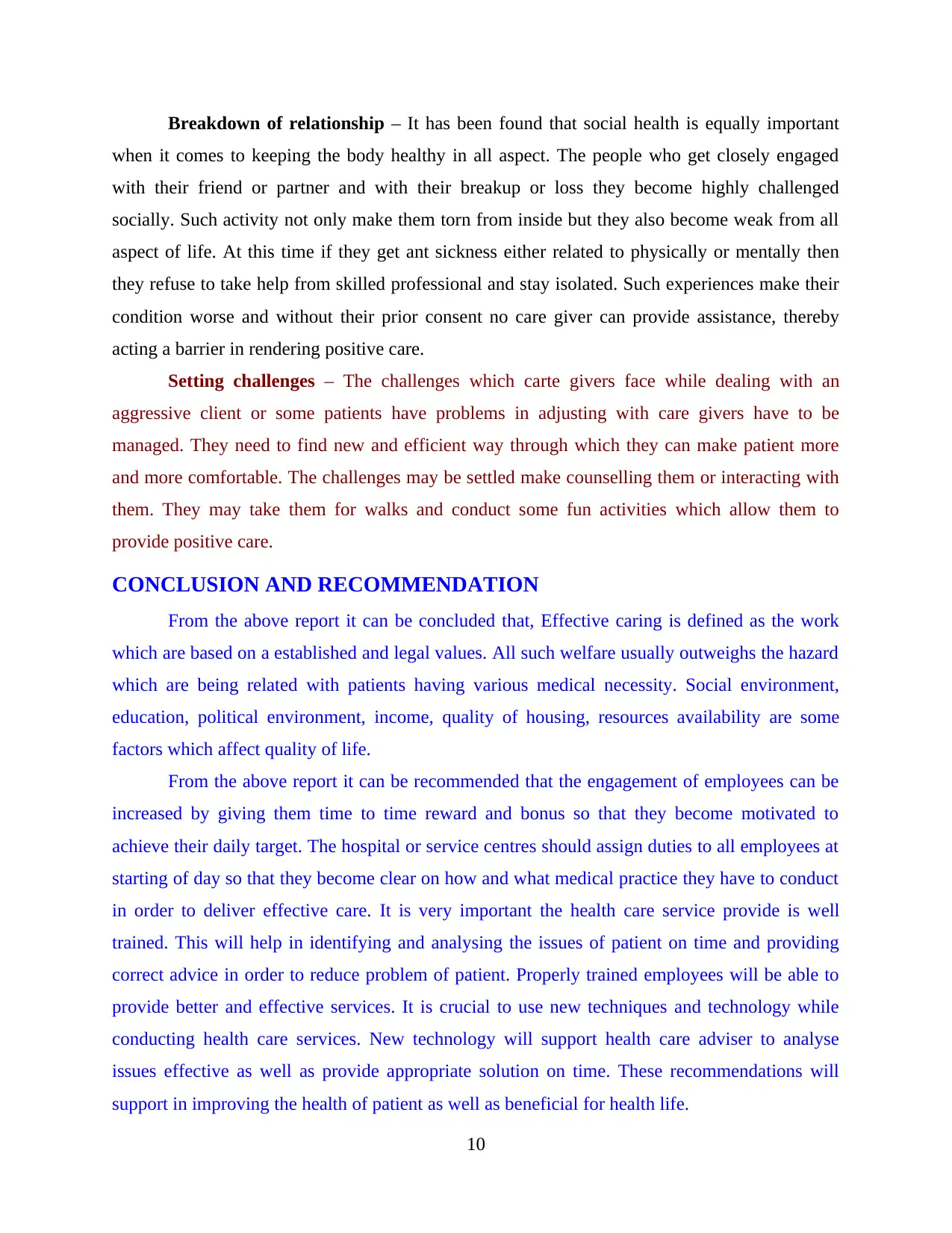
Breakdown of relationship – It has been found that social health is equally important
when it comes to keeping the body healthy in all aspect. The people who get closely engaged
with their friend or partner and with their breakup or loss they become highly challenged
socially. Such activity not only make them torn from inside but they also become weak from all
aspect of life. At this time if they get ant sickness either related to physically or mentally then
they refuse to take help from skilled professional and stay isolated. Such experiences make their
condition worse and without their prior consent no care giver can provide assistance, thereby
acting a barrier in rendering positive care.
Setting challenges – The challenges which carte givers face while dealing with an
aggressive client or some patients have problems in adjusting with care givers have to be
managed. They need to find new and efficient way through which they can make patient more
and more comfortable. The challenges may be settled make counselling them or interacting with
them. They may take them for walks and conduct some fun activities which allow them to
provide positive care.
CONCLUSION AND RECOMMENDATION
From the above report it can be concluded that, Effective caring is defined as the work
which are based on a established and legal values. All such welfare usually outweighs the hazard
which are being related with patients having various medical necessity. Social environment,
education, political environment, income, quality of housing, resources availability are some
factors which affect quality of life.
From the above report it can be recommended that the engagement of employees can be
increased by giving them time to time reward and bonus so that they become motivated to
achieve their daily target. The hospital or service centres should assign duties to all employees at
starting of day so that they become clear on how and what medical practice they have to conduct
in order to deliver effective care. It is very important the health care service provide is well
trained. This will help in identifying and analysing the issues of patient on time and providing
correct advice in order to reduce problem of patient. Properly trained employees will be able to
provide better and effective services. It is crucial to use new techniques and technology while
conducting health care services. New technology will support health care adviser to analyse
issues effective as well as provide appropriate solution on time. These recommendations will
support in improving the health of patient as well as beneficial for health life.
10
when it comes to keeping the body healthy in all aspect. The people who get closely engaged
with their friend or partner and with their breakup or loss they become highly challenged
socially. Such activity not only make them torn from inside but they also become weak from all
aspect of life. At this time if they get ant sickness either related to physically or mentally then
they refuse to take help from skilled professional and stay isolated. Such experiences make their
condition worse and without their prior consent no care giver can provide assistance, thereby
acting a barrier in rendering positive care.
Setting challenges – The challenges which carte givers face while dealing with an
aggressive client or some patients have problems in adjusting with care givers have to be
managed. They need to find new and efficient way through which they can make patient more
and more comfortable. The challenges may be settled make counselling them or interacting with
them. They may take them for walks and conduct some fun activities which allow them to
provide positive care.
CONCLUSION AND RECOMMENDATION
From the above report it can be concluded that, Effective caring is defined as the work
which are based on a established and legal values. All such welfare usually outweighs the hazard
which are being related with patients having various medical necessity. Social environment,
education, political environment, income, quality of housing, resources availability are some
factors which affect quality of life.
From the above report it can be recommended that the engagement of employees can be
increased by giving them time to time reward and bonus so that they become motivated to
achieve their daily target. The hospital or service centres should assign duties to all employees at
starting of day so that they become clear on how and what medical practice they have to conduct
in order to deliver effective care. It is very important the health care service provide is well
trained. This will help in identifying and analysing the issues of patient on time and providing
correct advice in order to reduce problem of patient. Properly trained employees will be able to
provide better and effective services. It is crucial to use new techniques and technology while
conducting health care services. New technology will support health care adviser to analyse
issues effective as well as provide appropriate solution on time. These recommendations will
support in improving the health of patient as well as beneficial for health life.
10
Paraphrase This Document
Need a fresh take? Get an instant paraphrase of this document with our AI Paraphraser
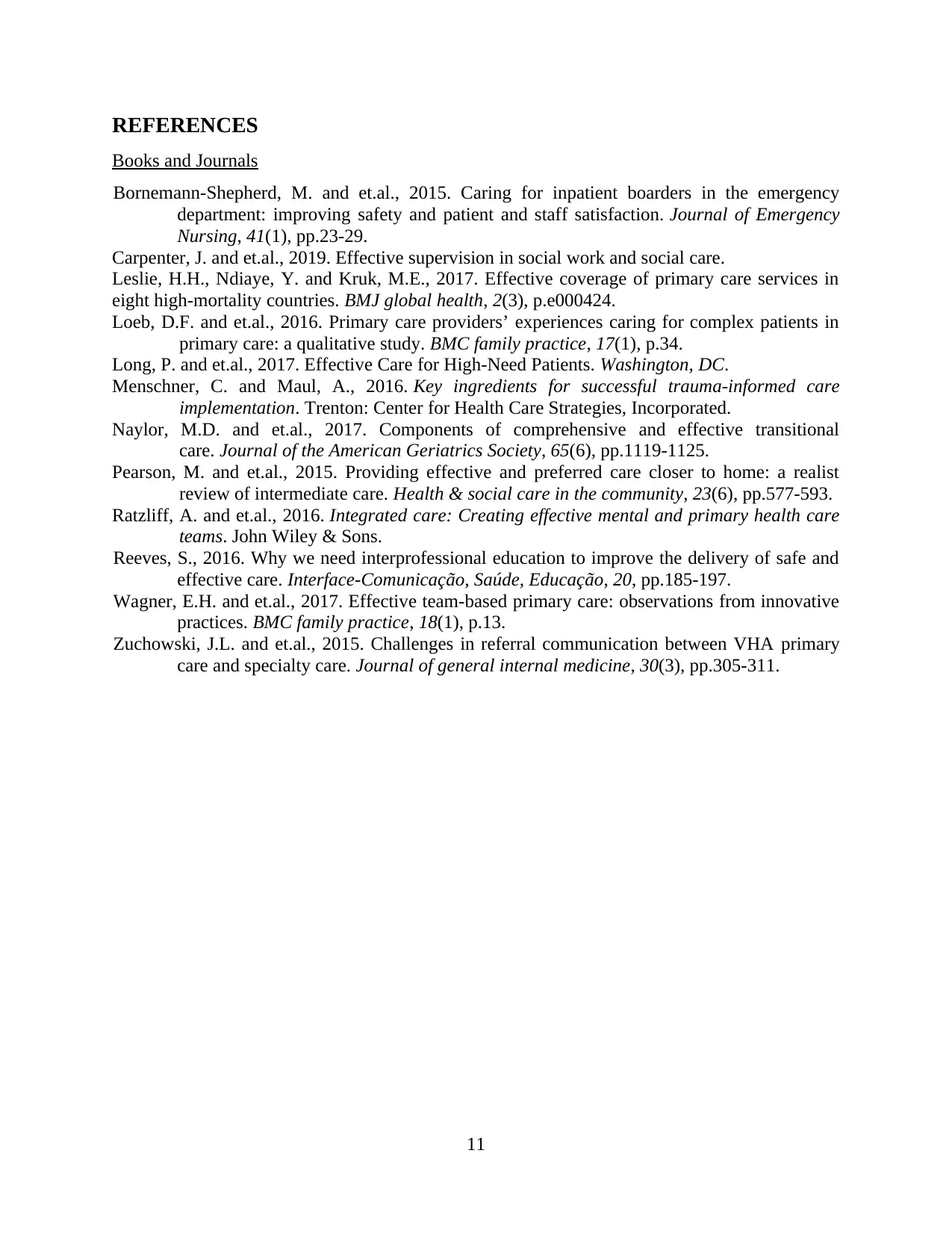
REFERENCES
Books and Journals
Bornemann-Shepherd, M. and et.al., 2015. Caring for inpatient boarders in the emergency
department: improving safety and patient and staff satisfaction. Journal of Emergency
Nursing, 41(1), pp.23-29.
Carpenter, J. and et.al., 2019. Effective supervision in social work and social care.
Leslie, H.H., Ndiaye, Y. and Kruk, M.E., 2017. Effective coverage of primary care services in
eight high-mortality countries. BMJ global health, 2(3), p.e000424.
Loeb, D.F. and et.al., 2016. Primary care providers’ experiences caring for complex patients in
primary care: a qualitative study. BMC family practice, 17(1), p.34.
Long, P. and et.al., 2017. Effective Care for High-Need Patients. Washington, DC.
Menschner, C. and Maul, A., 2016. Key ingredients for successful trauma-informed care
implementation. Trenton: Center for Health Care Strategies, Incorporated.
Naylor, M.D. and et.al., 2017. Components of comprehensive and effective transitional
care. Journal of the American Geriatrics Society, 65(6), pp.1119-1125.
Pearson, M. and et.al., 2015. Providing effective and preferred care closer to home: a realist
review of intermediate care. Health & social care in the community, 23(6), pp.577-593.
Ratzliff, A. and et.al., 2016. Integrated care: Creating effective mental and primary health care
teams. John Wiley & Sons.
Reeves, S., 2016. Why we need interprofessional education to improve the delivery of safe and
effective care. Interface-Comunicação, Saúde, Educação, 20, pp.185-197.
Wagner, E.H. and et.al., 2017. Effective team-based primary care: observations from innovative
practices. BMC family practice, 18(1), p.13.
Zuchowski, J.L. and et.al., 2015. Challenges in referral communication between VHA primary
care and specialty care. Journal of general internal medicine, 30(3), pp.305-311.
11
Books and Journals
Bornemann-Shepherd, M. and et.al., 2015. Caring for inpatient boarders in the emergency
department: improving safety and patient and staff satisfaction. Journal of Emergency
Nursing, 41(1), pp.23-29.
Carpenter, J. and et.al., 2019. Effective supervision in social work and social care.
Leslie, H.H., Ndiaye, Y. and Kruk, M.E., 2017. Effective coverage of primary care services in
eight high-mortality countries. BMJ global health, 2(3), p.e000424.
Loeb, D.F. and et.al., 2016. Primary care providers’ experiences caring for complex patients in
primary care: a qualitative study. BMC family practice, 17(1), p.34.
Long, P. and et.al., 2017. Effective Care for High-Need Patients. Washington, DC.
Menschner, C. and Maul, A., 2016. Key ingredients for successful trauma-informed care
implementation. Trenton: Center for Health Care Strategies, Incorporated.
Naylor, M.D. and et.al., 2017. Components of comprehensive and effective transitional
care. Journal of the American Geriatrics Society, 65(6), pp.1119-1125.
Pearson, M. and et.al., 2015. Providing effective and preferred care closer to home: a realist
review of intermediate care. Health & social care in the community, 23(6), pp.577-593.
Ratzliff, A. and et.al., 2016. Integrated care: Creating effective mental and primary health care
teams. John Wiley & Sons.
Reeves, S., 2016. Why we need interprofessional education to improve the delivery of safe and
effective care. Interface-Comunicação, Saúde, Educação, 20, pp.185-197.
Wagner, E.H. and et.al., 2017. Effective team-based primary care: observations from innovative
practices. BMC family practice, 18(1), p.13.
Zuchowski, J.L. and et.al., 2015. Challenges in referral communication between VHA primary
care and specialty care. Journal of general internal medicine, 30(3), pp.305-311.
11
1 out of 11
Related Documents
Your All-in-One AI-Powered Toolkit for Academic Success.
+13062052269
info@desklib.com
Available 24*7 on WhatsApp / Email
![[object Object]](/_next/static/media/star-bottom.7253800d.svg)
Unlock your academic potential
Copyright © 2020–2025 A2Z Services. All Rights Reserved. Developed and managed by ZUCOL.





